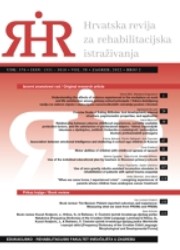MOTOR ABILITIES OF CHILDREN WITH CHILDHOOD APRAXIA OF SPEECH
MOTOR ABILITIES OF CHILDREN WITH CHILDHOOD APRAXIA OF SPEECH
Author(s): Dora KneževićSubject(s): Cognitive Psychology, Developmental Psychology
Published by: Sveučilište u Zagrebu, Edukacijsko-rehabilitacijski fakultet
Keywords: apraxia of speech; motor abilities; fine motor skills; motor comorbidity; developmental coordination disorder;
Summary/Abstract: Previous studies on fine and gross motor skills of children with childhood apraxia of speech (CAS) have reported inconclusive results. In this study, we investigate the motor abilities of children with CAS by focusing on three distinct motor factors: control during movement, fine motor skills/handwriting, and general coordination. Participants included 25 children with CAS and 20 age-matched typically developing (TD) children between the ages of 5 and 7 years. Motor abilities were evaluated using a parent questionnaire - the Croatian version of The Developmental Coordination Disorder Questionnaire (DCDQ-HR). Compared to age-matched TD children, those with CAS showed significantly poorer overall motor ability based on the DCDQHR, as well as on all three motor factors: control during movement, fine motor skills/handwriting, and general coordination. Even though their results were worse than TD children, they were still within the range that indicates normal motor abilities. Among the three motor factors considered, children with CAS exhibited significant problems with fine motor skills/handwriting. Children with CAS may not be categorised as children with motor deficits, but they exhibit poor overall motor abilities, especially fine motor skills, compared to TD children. This study supports the premise that co-occurring language impairment is an important variable to consider when discussing motor abilities in CAS.
Journal: Hrvatska revija za rehabilitacijska istrazivanja
- Issue Year: 58/2022
- Issue No: 2
- Page Range: 81-91
- Page Count: 11
- Language: English

